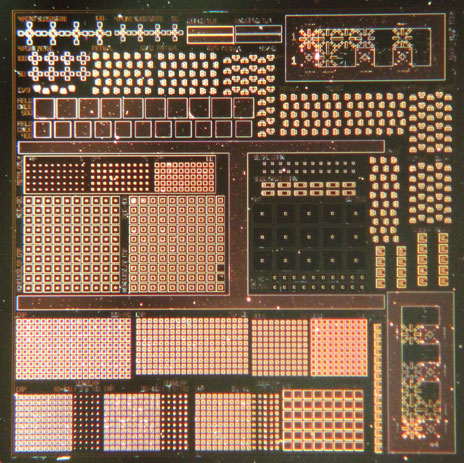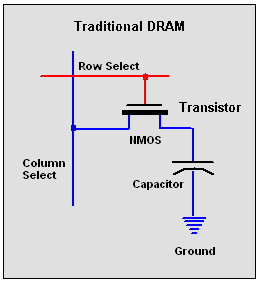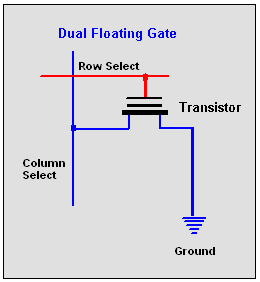Combined Memory - Flash and DRAM on One Chip
Gadget Memory
Almost every consumer electronic device uses memory of some type as part of its design. This includes computers (desktop, notebook, netbook, tablet, and smartphone), music players, game consoles, and the like.
Within these devices are two types of memory.
One is more or less permanent and is typically used to store programming that will always be part of the device. As such this memory must be able to hold what is in it whether or not the power is turned on. This is typically called Read Only Memory or ROM.
The other type of memory is only used while the device is on. This memory is used as temporary storage to hold programs as they are running and it called Random Access Memory or RAM.
Because the purpose of each type of memory is different and because one is designed to work whether the device is on or off (ROM) and the other to work only while the devices is operating (RAM) they are typically two completely sets of chips in the same device. In other words every device that uses both types of memory has at least one chip for ROM and another for RAM.
As you may imagine this takes up room in the device.
What if a design could be made that contained both types of memory on one chip? The memory could be reconfigured on-the-fly and it would take up less real estate in the device was well.
Engineers and students at the North Carolina State University are exploring just such a device.



Unified Memory
The team at NCSU have taken the design of a traditional flash memory (RAM) and modified it slightly.
Traditional Flash Memory Function
The traditional flash memory design works by forcing an electrical charge onto a layer of metal or crystalline silicon. This layer is called a floating gate. The charge (or lack of charge) determines the transistor's state. An "on" charge on the gate represents a 1, and a lack of charge represents a 0. To hold the charge on the gate a barrier of dielectrics (insulators) arrayed around the gate keeps that charge from bleeding away. This way, even when the memory has no power, the state on that gate is held. This is the way Read Only Memory (ROM) typically operates. Forcing and holding charges on this type of memory makes it slower to react to changes in state.
Alternatively, Dynamic Random Access Memory (DRAM) is much faster. Rather than surrounding a gate with insulating material to have it hold a charge, RAM uses capacitors (tiny devices that holds electricity) to hold the charge on each transistor. Because RAM does not need to retain its state when power is turned off, using capacitors to hold the state is an excellent solution.
What is a Floating Gate
All transistors use what are called gates to change their state; on or off. The gate, in essence, is the switch in the transistor. (see second image right). As transistors have gotten smaller it was no longer necessary for the gate to be in direct contact with the source (electrically active) and drain (to circuit) contact in the transistor. Such transistors are called Field Effect Transistors and the gate floats above the source and drain. Power applied to the floating gate can cause current to flow between the source and drain, even though the gate itself is not in direct contact with the source and drain.
Two Floating Gates
The NCSU team decided to modify the way transistors are formed on their traditional ROM memory so that it can function as both ROM and RAM. To do this they built transistors that have two gates (rather than one). The additional gate helps holds a charge on the first gate, but is considerably faster switching that traditional ROM.
By holding a charge on the first floating gate the memory can act as non-volatile (or ROM) memory, but by using a second gate that is controlled by a constant source of power the transistor can change state much faster, much the way RAM does.
The Design is Significant
This is a significant advance, as simple as it sounds, because if this proof of concept works it will reduce the number of chips required in consumer electronic devices. Perhaps best of all the new transistor design can be created with existing technology. That means no new fabrication equipment has to be build and purchased.
With a unified memory the following can be accomplished in our devices:
- fewer memory chips
- less costly memory chips
- lower power requirements
Traditional vs Twin Floating Gate Memory
Traditional Flash ROM
One of the challenges with this new design has to do with the number of life-cycles flash ROM currently has. Because flash requires a strong electrical field to be maintained in the transistor they eventually wear out. Current flash ROM designs have a mean time between failure figure of about one hundred thousand write cycles. This is the result of that strong electrical field wearing away the insulating layer (dialectic) in these transistor. Eventually memory sticks and the ubiquitous flash drives will fail. A fact that many consumers are not aware of.
Unified Memory
Professors Paul Franzon and Neil Di Spigna, feel that using two neighboring floating gates will take the energy storage burden off of the dielectric thereby causing their device design to last considerably longer. The benefits of the design are two-fold. Extend the life of the memory serving as ROM while making writes to that memory considerably faster. In the process, if this proof of concept succeeds, they will have created a memory transistor that can serve as both ROM and RAM interchangeably.
Wrap Up
Should this new design bear fruit we can expect yet another drop in the memory prices. Consumer electronics, rather than having two separate types of memory embedded will have one. That one memory type will serve as both permanent and temporary storage. With the permanent storage having a much longer service life that can currently be expected.
Other benefits will be:
- faster writes to permanent memory storage
- longer lasting permanent memory storage
- cheaper memory translating to cheaper devices
- smaller devices
- lower power requirements
Disclaimer
The author was not compensated in any way, monetarily, with discounts, or freebies by any of the companies mentioned.
Though the author does make a small profit for the word count of this article none of that comes directly from the manufacturers mentioned. The author also stands to make a small profit from advertising attached to this article.
The author has no control over either the advertising or the contents of those ads.








